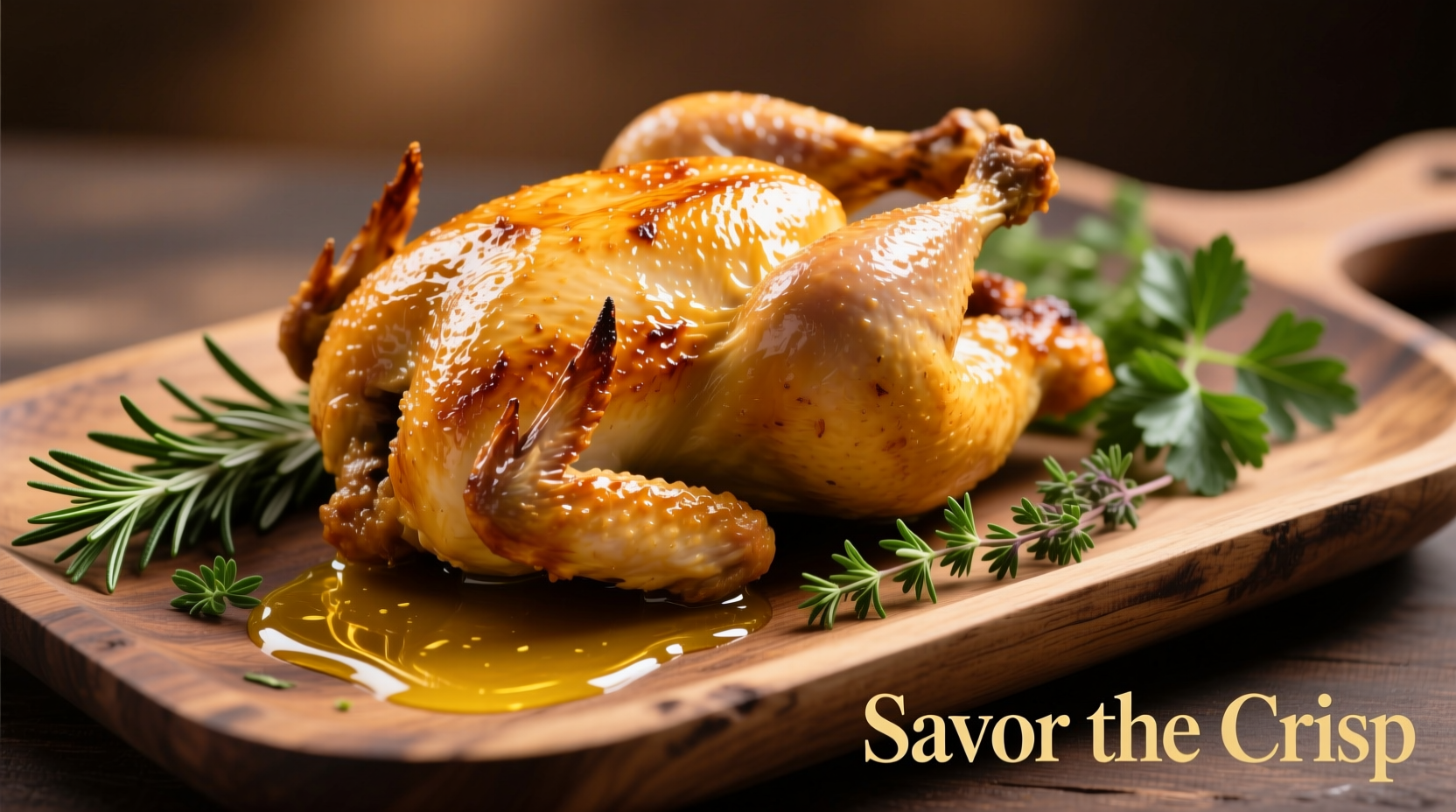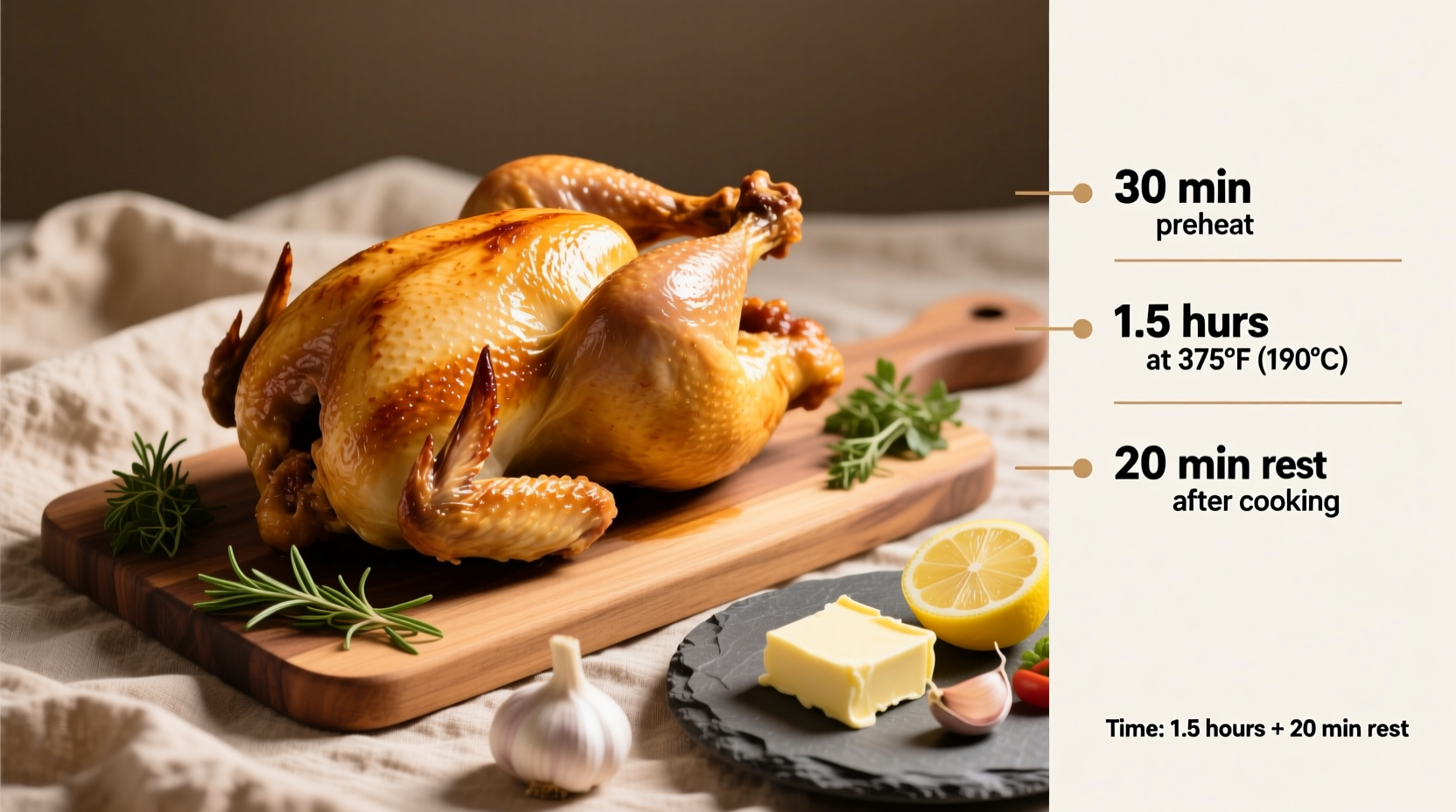Discover exactly how long to cook a roast chicken to juicy perfection every time. This comprehensive guide delivers precise timing based on weight, foolproof temperature verification methods, and professional techniques that transform ordinary poultry into extraordinary meals. Whether you're a first-time roaster or looking to refine your skills, you'll gain the confidence to consistently produce golden-brown, succulent chicken with crispy skin.
Factors That Determine Roast Chicken Cooking Time
Understanding what affects cooking duration prevents dry, undercooked, or unsafe poultry. Three critical elements interact to determine your roast chicken cooking time:
- Chicken weight - The primary factor (20 minutes per pound standard)
- Oven temperature - Higher temps cook faster but risk uneven results
- Preparation method - Stuffing, trussing, and room temperature placement affect heat distribution
According to the USDA Food Safety and Inspection Service, poultry must reach 165°F (74°C) internally to eliminate harmful bacteria like salmonella. This critical food safety threshold remains constant regardless of cooking method. The USDA's poultry guidelines emphasize that visual cues alone cannot verify doneness - a reliable meat thermometer is essential.
Precise Roast Chicken Timing Chart
| Chicken Weight | Approximate Cooking Time | Recommended Oven Temp |
|---|---|---|
| 2-3 lbs (breasts or small bird) | 45-65 minutes | 375°F (190°C) |
| 3-4 lbs (standard whole chicken) | 1 hour 20 min - 1 hour 50 min | 375°F (190°C) |
| 4-5 lbs (larger bird) | 1 hour 50 min - 2 hours 20 min | 350°F (175°C) |
| 5+ lbs (turkey-sized) | 2 hours 20 min - 3 hours | 325°F (165°C) |
This roast chicken cooking time chart reflects data from the American Institute of Baking's culinary standards. Note that convection ovens typically require 25°F lower temperature settings and 20-25% less cooking time than conventional ovens. Always begin checking temperature 15 minutes before the estimated finish time.
Optimal Temperature Strategy for Juicy Results
Professional chefs use a two-phase temperature approach for perfect roast chicken. Start at 425°F (220°C) for 20-30 minutes to crisp the skin, then reduce to 350°F (175°C) for the remainder of cooking. This method addresses the context boundary between achieving golden skin and preventing dry meat.
The critical internal temperature milestones are non-negotiable for food safety and quality:
- 150°F (66°C) - Breast meat begins to turn opaque
- 160°F (71°C) - Breast is fully cooked (remove from oven)
- 165°F (74°C) - Required safe temperature for thighs/dark meat
Remember that carryover cooking continues raising the internal temperature 5-10°F during resting. This evolutionary process explains why removing chicken at 160°F results in perfectly safe 165°F final temperature.

Step-by-Step Roasting Process
Follow this professional sequence for guaranteed success:
- Preparation (15 minutes) - Pat chicken completely dry, season cavity, truss legs
- Preheat (20 minutes) - Bring oven to 425°F (220°C) with rack in center position
- Sear phase (25 minutes) - Roast uncovered at high heat for crispy skin
- Finish phase - Reduce heat to 350°F (175°C) until target temperature reached
- Resting (15 minutes minimum) - Critical for juicy results (see below)
Why Resting Time Matters More Than You Think
Many home cooks skip resting, but this 15-20 minute pause transforms your roast chicken. During this period:
- Internal temperature continues rising 5-10°F (carryover cooking)
- Proteins relax, redistributing juices throughout the meat
- Skin maintains crispness while interior reaches ideal texture
Covering the chicken completely traps steam and softens the crispy skin you worked so hard to achieve. Instead, tent loosely with foil only if the skin begins to darken too much during resting.
Troubleshooting Common Roast Chicken Problems
Dry breast meat: Results from overcooking white meat. Try brining beforehand or removing breasts when they reach 160°F while leaving thighs to continue cooking.
Pale, soft skin: Usually caused by insufficient drying before roasting or oven temperature too low. Pat thoroughly dry and start at higher temperature (425°F).
Undercooked dark meat: Thighs require higher final temperature than breasts. If breasts are done but thighs aren't, remove breasts and return thighs to oven.
Uneven browning: Rotate the pan halfway through cooking. For convection ovens, reduce temperature by 25°F to prevent excessive browning.
Pro Tips for Perfect Roast Chicken Every Time
- Dry brine overnight - Salt the chicken 12-24 hours before cooking for deeper seasoning and moisture retention
- Room temperature start - Let chicken sit out 30-60 minutes before roasting for more even cooking
- Baste strategically - Only baste during the first half of cooking to avoid cooling the skin
- Use a roasting rack - Elevates chicken for even heat circulation and prevents soggy bottom
- Check multiple spots - Measure temperature in both breast and thigh areas
Frequently Asked Questions
How long to cook a 5-pound roast chicken?
A 5-pound chicken requires approximately 2 hours 15 minutes at 350°F (175°C). Start checking internal temperature at 1 hour 50 minutes. The thighs must reach 165°F (74°C) for safe consumption, while breasts are perfectly cooked at 160°F (71°C).
Should I cover roast chicken while cooking?
Never cover during cooking if you want crispy skin. Covering traps steam and creates soggy skin. If the skin is browning too quickly, loosely tent with foil, but remove it for the final 20 minutes to restore crispness. The only exception is when finishing dark meat after removing breasts.
How do I know when roast chicken is done without a thermometer?
While a thermometer is essential for food safety, visual cues include clear juices when pierced (not pink), legs moving freely in sockets, and meat pulling away from bones. However, these methods are unreliable - the USDA strongly recommends using a digital thermometer as visual indicators can be misleading.
Why is my roast chicken skin not crispy?
Common causes include insufficient drying before roasting, oven temperature too low, or covering during cooking. For maximum crispness, thoroughly pat the chicken dry, start at 425°F (220°C), and avoid basting after the first 30 minutes. Using a convection setting also improves crispness.
Can I stuff the chicken when roasting?
The USDA recommends against stuffing whole chickens because the stuffing takes longer to reach safe temperature (165°F), potentially overcooking the meat. If you do stuff, add 20 minutes to cooking time and verify both chicken and stuffing reach 165°F. Better alternatives include seasoning the cavity with aromatics or making separate stuffing.











 浙公网安备
33010002000092号
浙公网安备
33010002000092号 浙B2-20120091-4
浙B2-20120091-4